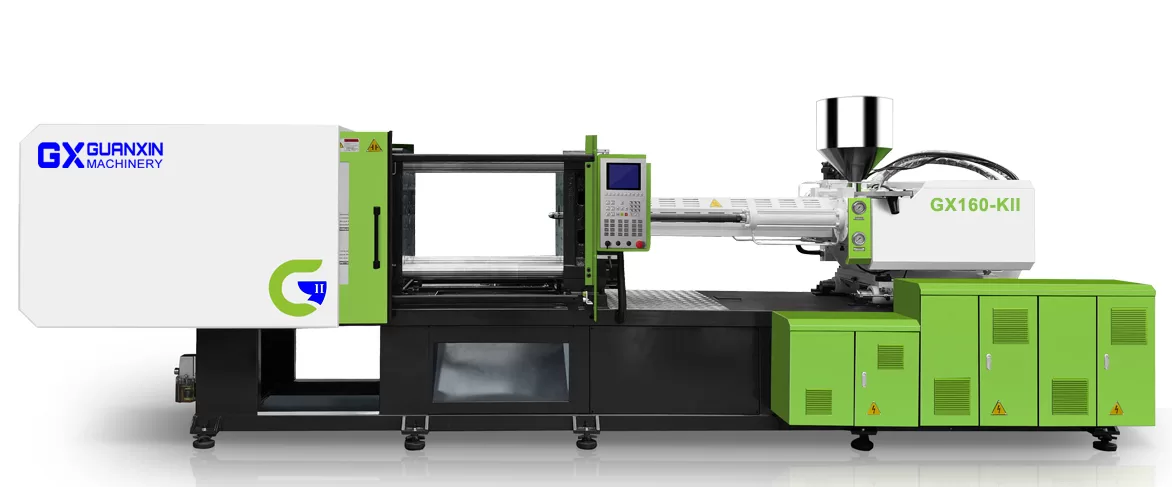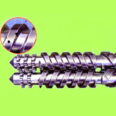
The many styles of mobile phone cases seen on the market make many people love it. Not only can they protect their phones, but they can also make their phones look stylish and unique. Generally, mobile phone case manufacturers make mobile phones from raw materials to the end. The finished shell products need to go through the main steps of mold opening production, mold trial, sample confirmation, injection molding production, surface spraying treatment, and assembly. Generally, plastic mobile phone cases are produced by Phone Case Maker Machine – optimized injection molding machines. What about the turnkey solutions for making phone cases?
Guanxin had launched 2 types of mobile cover making machine in the mobile back cover manufacturing industry. They are normal plastic mobile cover making machines and silicone phone case making machines. The traditional plastics like TPU, PP, PC, ABS will need the the normal mobile phone case making machines for production. But the silicone mobile cover will need different silicone injection molding equipment. It is called liquid silicone injection molding machine (Click for detailed introduction). This silicone phone case making machine requires the liquid silicone metering and dosing machine to work together. As the silicone mobile cover is made by liquid injection molding ( LIM ) process.

Plastics Phone Case Maker Machines are include below machines:
Plastic Injection Molding Machine
Mobile Phone Case Injection Molds
Hopper Dryer
Material Auto Loader
Material Mixer
Air Compressor
Water Chiller
Automatic Robot Arm
Silicone Phone Case Making Machine include below equipment:
Liquid Silicone Injection Molding Machine
Liquid Silicone Mobile Cover Injection Molding Mold
Liquid Silicone Metering and Dosing Equipment
Air Compressor
Water Chiller
Automatic Robot Arm
Mobile phone protective cases are mass-automated production using general precision level 5. The wall thickness of most mobile phone covers is about 1.5mm, and the protruding part inside the mobile phone case is less than 5%. In the current automatic production of mobile phone protective cases, forced demoulding is adopted. Then it is taken out by a robot arm for 24-hour non-stop automatic manufacturing production.
| Name | Detailed Specification of Mobile Cover injection Mold |
|---|---|
| Cell Phone Case Application Brands: | Iphone, Huawei, Xiaomi, Oppo, Vivo, Samsung, Google Pixel Phones, Motorola, Lenovo,LG, Asus, Realme, Tecno Mobile, Sony,ZTE, Nokia, |
| Mobile Cover Injection Mold Cavities: | 1 or 2, or 4 mostly, Now some manufacturer is running 6 ~ 8 cavity production line. |
| Ejection Method: | By hand or Auto-Robot |
| Mobile Phone Cover Making Materials: | TPU, PC, PP, ABS are mostly used, But some quality mobile back cover are made by liquid silicone. |
| Phone Back Cover Mold Steel: | S50C, 718H, 738, SKD61, SCM435, ETC |
| Phone Case Mold Manufacturing Processing: | CNC Machining, Wire Cut, Grinding, Drilling, Polishing, etc |

Phone Case Maker Machine Introduction
Guanxin Mobile phone case maker machine is a dedicated optimized injection molding machine for mobile phone`s protector manufacturing application. This phone cases making machine is optimized with the injection screw and barrel with is bi-metallic material for PC, Silicone supplier for soft silicone phone case, hydraulic driving system, higher injection speed and pressure. This mobile cover maker machine is mainly used to manufacture cell phone case by PC, Elastomers and other raw material. We are trying to offer the phone case machine maker to have light weight, high precision mobile phone case and protector.
Plastic Mobile Phone Case Manufacturing Process
Mobile phone cover are usually made of PC (polycarbonate) or PC+ABS. Due to the poor fluidity of PC (physical properties are shown in the table below), the mobile cover making process usually uses high mold temperature and high material temperature to fill the mobile phone case cavity; The mobile phone cover injection mold usually is designed with a point gate. Grading injection is required for filling. Finding the position of the gate and the VP (injection-holding pressure) switching position will be great help in solving abnormalities such as gate gas marks and underfill flash.
The following are the key points of the molding conditions of mobile phone cover products, introducing the points of attention to the setting of molding parameters such as melt temperature, mold temperature, injection speed, back pressure, etc.
| Phone Case Injection Molding Process | Plastic Phone Case Manufacturing Process Controlling Method |
|---|---|
| Melting temperature | The optimal molding temperature setting is related to many factors, such as the size of the phone cover making machine, screw configuration, mold and molded product design, and molding cycle time. Generally speaking, in order to gradually melt the plastic, a lower temperature is set in the rear section/feeding zone of the material pipe, and a higher temperature is set in the front section of the material pipe. However, if the screw design is improper or the L/D value is too small, the reverse temperature setting is also possible. |
| mold temperature | In terms of mold temperature, high-temperature molds can provide better surface appearance, with less residual stress, and are easier to fill for thinner or longer molded products. The low mold temperature can shorten the molding cycle. |
| Screw rotation speed | 40 to 70 rpm is recommended, but it depends on the mobile back cover making machine and screw design. |
| Injection Pressure | In order to fill the mold as quickly as possible, the higher the injection pressure, the better, generally about 850 to 1,400kg/cm2, and the highest can reach 2,400kg/cm2. |
| Injection speed | The rate of fire has a lot to do with the gate design. When using direct gates or edge gates, a slower rate of fire should be used in order to prevent sun glare and wave flow marks. In addition, if the thickness of the finished product is above 5MM, slow injection will help avoid bubbles or dents. Generally speaking, the principle of the rate of fire is that the thinner is fast, and the thicker is slow.
When switching from injection molding to holding pressure, the holding pressure should be as low as possible to avoid residual stress in the molded product. The residual stress can be removed or reduced by annealing; the condition is 120°C to 130°C for about 30 minutes to one hour. |
| Back pressure | Generally, the lower the setting, the better, but for uniform feeding, it is recommended to use 3 to 14 kg/cm2. |
PlasticS Mobile Phones Case Injection Molding defects and Troubleshooting Solutions
| Common defects / Injection Troubles | Reasons | Trouble Shooting Solutions | |||
|---|---|---|---|---|---|
| Short injection: | increase injection pressure, speed, increase material temperature, mold temperature, and increase the amount of glue. | ||||
| Gas mark | Reduce the flow rate of the melt through the gate and increase the mold temperature. | ||||
| Black spot | 1. The proportion of raw materials is too high 2. The screw is not cleaned 3. Poor workshop environment |
1. Control the proportion of inferior materials and prohibit the mixing of heterochromatic raw and inferior materials 2. Develop phone cover maker machine maintenance, refueling and cleaning check and audit 3. Change the workshop environment and improve the cleanliness of the workshop |
|||
| Flashing, piping | 1. The injection pressure is too high 2. Insufficient clamping force of mobile cover manufacturing machine 3. The accuracy of the mobile cover making machine is poor 4. Because the employees were not serious in their work and the product was not taken out, the stamper and mold were damaged, causing the product to run away. |
1. Improve the accuracy of the mold, and use high-hardness steel as the mold profile to prevent flash. The quenched and ground precision mold (block-plate combined type) is more reliable against flash. If the hardness reaches about HRC60. Ordinary molds (45 steel) are about to be repaired for about 100,000 molds, and they have been seriously damaged after about 300,000 molds. 2. From the aspect of molding process, the process conditions are mainly set in the direction of reducing fluidity. Reduce injection pressure, lower melt temperature and mold temperature, reduce injection speed, and reduce feed volume. |
|||
| Weld Line | If excessive release agent is used, the fusion line will become thicker, the release agent is pushed forward by the melt, and the release agent is mixed between the forwards of the two streams, blocking the fusion of the forwards and weakening the mechanical strength. | 1. Control mold temperature and material temperature 2. Adjust the glue flow of each section and add exhaust. |
|||
| Big gate | 1. The mold temperature is too low; 2. The fluidity of the material is low. 3. The glue position of the product is thin and difficult to remove. 4. Poor mold exhaust |
1. Increase the mold temperature 2. Improve material fluidity 3. Change the position of the gate, generally designed on the thick wall 4. Increase vent holes| |
|||
| Deformed | 1. Uneven temperature 2. Uneven pressure 3. Molecular orientation 4. Improper gate position |
Control mold temperature to prevent mold temperature differences from occurring Shorten the uneven deformation, adjust the pressure after the process |
|||
| shrink | A. Improper molding process conditions (when injection pressure is insufficient, mold cooling is insufficient) B. The wall of the product is too thick or uneven C. The shrinkage of the raw material is too large (material problem) D. Shrinkage caused by uneven wall thickness of the product: There is often shrinkage on the back of the stiffener. Due to the uneven wall thickness of the stiffener, when the thickness is less than 50% of the wall thickness of the adjacent material, the shrinkage situation is obviously improved, but the width of the stiffener is at least 1MM, otherwise the mold manufacturing will be difficult, and the boss in the plastic part will have a similar situation |
1. Increase injection pressure 2. Extend the holding time (delay the sol backflow at the gate) 3. A lot of shrinkage is caused by the unreasonable design of runners and gates. To deal with such shrinkage, it is necessary to modify the mold to reduce the shrinkage. 4. For complex and thin-walled products, some need to use gas-assisted technology to control shrinkage when designing and manufacturing molds |
|||
